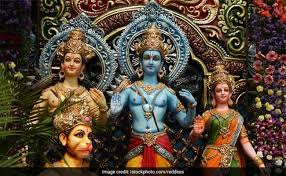|| Om Namoh Narayana Namah ||
For those who do not know, or have not read my last article on the ways of worshipping Lord Vishnu and it's forms during season change let me give you a dump on this.
India is a land of festivals and possibly the only country where you can see several seasons. Summer, Monsoon, Autumn, Winter and Spring. We can see their several transitions. These transitions are often attributed to the worship of Lord Vishnu and his forms.
So, let us see then how we are celebrating this transition of seasons and worshipping Lord Vishnu. In accordance to that do also notice that how different forms of moons are worshipped based on the changing of seasons.
*Transition from Winter to Spring*
This a major change in the season reflecting the arrival of the month of Falgun or Fagun. Worshipping the acts of the Avatar Lord Narsimha, the fourth avatar of Lord Vishnu, and his devotee Prahlad this festival was called as Dhulivandan, which literally meant, worshipping the dust. Why so? Because with the changing of the seasons and the wind direction the wind takes away the dust accumulated to other places and the soil now is ready to be ploughed. This festival is also called Holi, marking the end of the evil princess Holika, who conspired to kill Prahlad along with the evil Hirnyakashyap.
Holi is celebrated on a full moon day.
 |
| Image of Holika Dahan |
 |
| Dhulivandanam being celebrated as a festival of colors |
*Transition from Spring to Summer*
The Hindu month of Chaitra comes over here and so comes the famous fasting time of nine days of Chaitra Navaratri. However at the end of the nine days and on 9th day of the increasing moon or Shukla Paksha there is Ramnavami. Here Lord Vishnu's 7th Avatar Lord Rama's birth is celebrated. The moon is half moon on the brighter phase.
 |
| Ram-Navami celebrated in Chaitra |
*Transition from Summer to Monsoon*
The lunar month of Ashadha, starts the prelude to monsoon. This time the soil gathers moisture and it is the right time to sow the seeds for farming. This is also the time that the gantetic plains have the correct moisture in the sediments to start preparing the clay idols of Maa Durga and Lord Ganesha for the festive season ahead. On the second day of the brighter moon fortnight of Ashadha comes "RathYatra". Here we are essentially worshipping Lord Vishnu in the form of Lord Jagannath. Please note the moon is crescent over here.
 |
| Rath Yatra being celebrated in Jagannath Puri |
*Transition from Monsoon to Autumn*
Lord Krishna, the 8th Avatar of Lord Vishnu was born in exile and in a jail. He was born on the 8th day of the fading moon in the month of Bhadrapada. However, from this day onwards you see a recession in the rain and the season change to Autumn. This is also a half moon day, like Ramnavami, but it is on the darker phase and not in the brighter phase. The festival as you have all guessed it, is Janmashthami.
 |
| Celebration of Janmashthami marking the birth of Lord Krishna |
*Transition from Autumn to Winter*
Well this is one of the most popular festivals in India. Celebrated in the lunar month of Kartik when the temperatures start to dip, this festival is cebrated on a No moon day. This finishes the seasonal cycle and here we are worshipping again Lord Rama, but the occasion of his return to Ayodhya. This is celebrated with crackers and lights and this is called Diwali.
 |
| Diwali- The festival of lights celebrated on a no-moon day |
These are actually the festivals based on seasonal transitions specifically in Northern India. Of course, over the time these festivals have become in a way universal and have had a global appeal also. We see these festivals and many other Indian festivals being celebrated all across the world with great enthusiasm.
In Southern India, due to changes in seasonal transitions you also have festivals like
Onam (Commemorating Raja Bali)
Ugaadi
Pongal
So my friends....While you stay in that magnificent country, India, to enjoy her all colors and all festivals. Do understand that all these were created thousands of years ago to bind people with nature. That is why we call then Utsav, meaning enjoyment for all. There is no binding to this. That is why you do not need to be of a particular religion or a caste in order to enjoy these festivals. These festivals are so much bound religiously and scientifically that it provides a room for everybody. And we Indians, of course, need a reason to celebrate.
Today, you will find a lot of people trying to delineate these festivals and trying to make them religion specific. Let me tell you, these festivals do not have any copyright or ownership. Therefore, whoever you are, whatever you are, wherever you are, Lord Narayan will always bless you and will be in all your deeds, good or bad. Remember good deeds bring good result and bad deeds bring bad. That is the bottom-line, which needs to be respected and remembered.
Remember this shloka finally
Om apavitro pavitrava
Sarvavastane gatopiva
Ya smaretha pundarikaksha
Sa bhayena abhyantara suchi.
This means. Whatever is pure and whatever is assumed to be impure or bad, wherever it might be, is purified just by remembering Lord Narayana. So as to say that if this Universe is created by the Lord then everything present in it, however insignificant it may be, is a creation of the Lord. So be kind and be respectful.
Cheers
Kalyan
*||Om Namoh Narayanay Namah||*











